Analysis of Criminal Justice System and Stakeholder Roles in the UK
VerifiedAdded on 2023/01/12
|7
|1951
|24
Report
AI Summary
This report provides a comprehensive overview of the UK's legal system, focusing on criminal justice. It begins with an introduction to laws and legal systems, followed by an examination of the structure of magistrate and crown courts, the process of appeal, and the handling of criminal offenses within the criminal justice system. The report also evaluates the principal laws applied in specific cases. Task 2 delves into the criminal justice process, outlining its main stages and the roles of various stakeholders in delivering justice. It explores methods for measuring the effectiveness of the criminal justice process and analyzes stakeholders' effectiveness in reducing reoffending, supported by case law. The report concludes with a synthesis of the key concepts and findings, emphasizing the importance of laws in binding society and the role of stakeholders in ensuring justice. It also highlights the measures taken to strengthen the legal system and reduce reoffending rates through rehabilitation and landmark judgments. The report includes references to relevant books and journals.
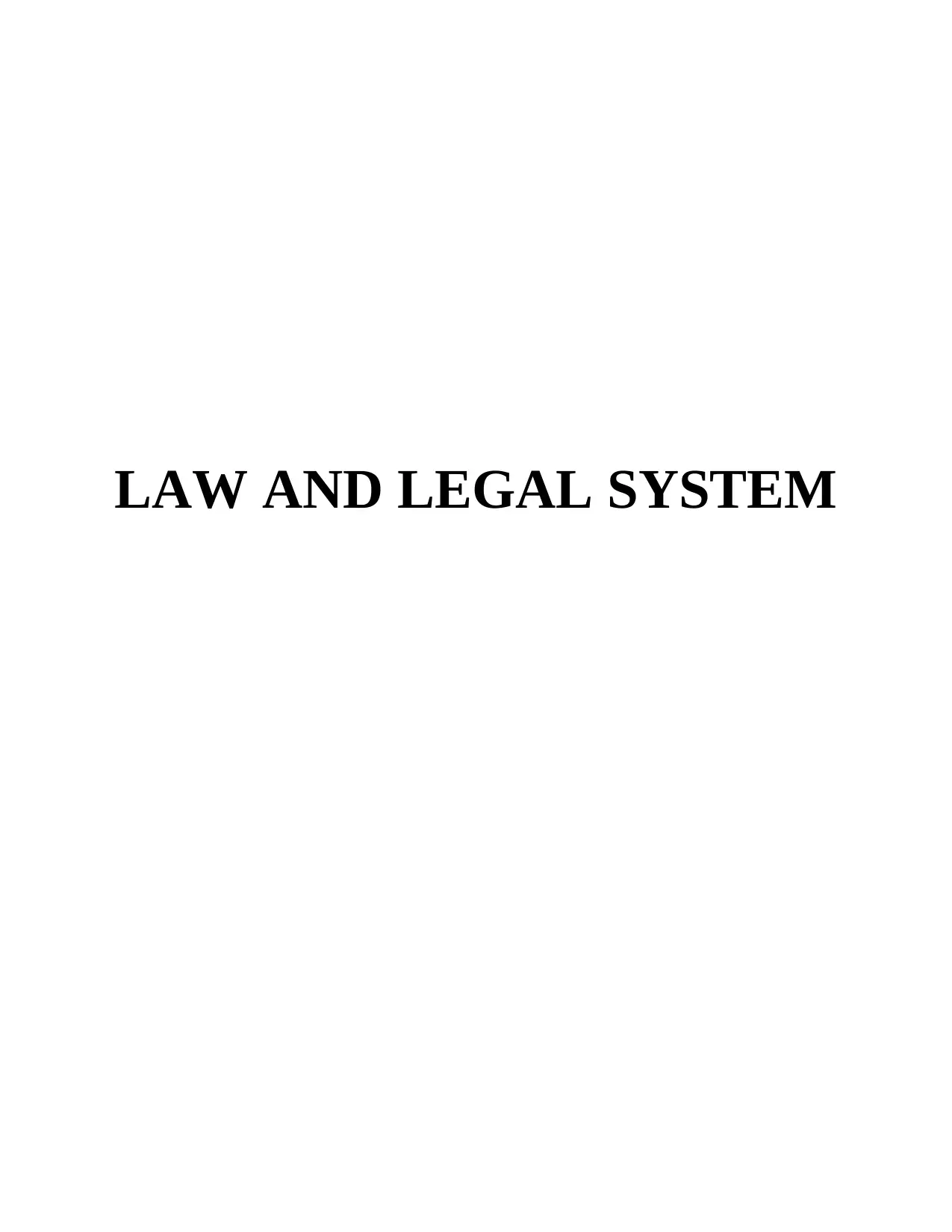
LAW AND LEGAL SYSTEM
Paraphrase This Document
Need a fresh take? Get an instant paraphrase of this document with our AI Paraphraser
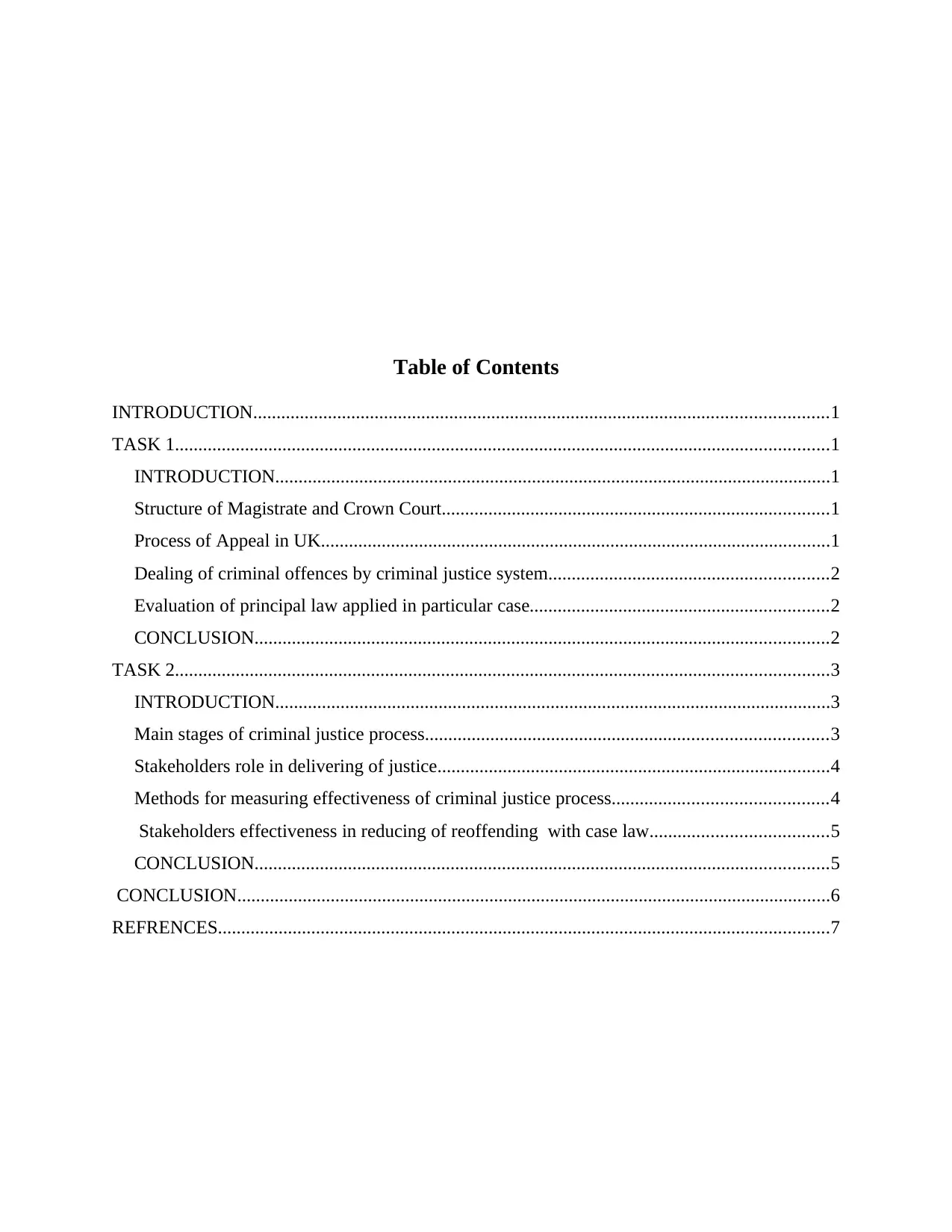
Table of Contents
INTRODUCTION...........................................................................................................................1
TASK 1............................................................................................................................................1
INTRODUCTION.......................................................................................................................1
Structure of Magistrate and Crown Court...................................................................................1
Process of Appeal in UK.............................................................................................................1
Dealing of criminal offences by criminal justice system............................................................2
Evaluation of principal law applied in particular case................................................................2
CONCLUSION...........................................................................................................................2
TASK 2............................................................................................................................................3
INTRODUCTION.......................................................................................................................3
Main stages of criminal justice process......................................................................................3
Stakeholders role in delivering of justice....................................................................................4
Methods for measuring effectiveness of criminal justice process..............................................4
Stakeholders effectiveness in reducing of reoffending with case law......................................5
CONCLUSION...........................................................................................................................5
CONCLUSION...............................................................................................................................6
REFRENCES...................................................................................................................................7
INTRODUCTION...........................................................................................................................1
TASK 1............................................................................................................................................1
INTRODUCTION.......................................................................................................................1
Structure of Magistrate and Crown Court...................................................................................1
Process of Appeal in UK.............................................................................................................1
Dealing of criminal offences by criminal justice system............................................................2
Evaluation of principal law applied in particular case................................................................2
CONCLUSION...........................................................................................................................2
TASK 2............................................................................................................................................3
INTRODUCTION.......................................................................................................................3
Main stages of criminal justice process......................................................................................3
Stakeholders role in delivering of justice....................................................................................4
Methods for measuring effectiveness of criminal justice process..............................................4
Stakeholders effectiveness in reducing of reoffending with case law......................................5
CONCLUSION...........................................................................................................................5
CONCLUSION...............................................................................................................................6
REFRENCES...................................................................................................................................7
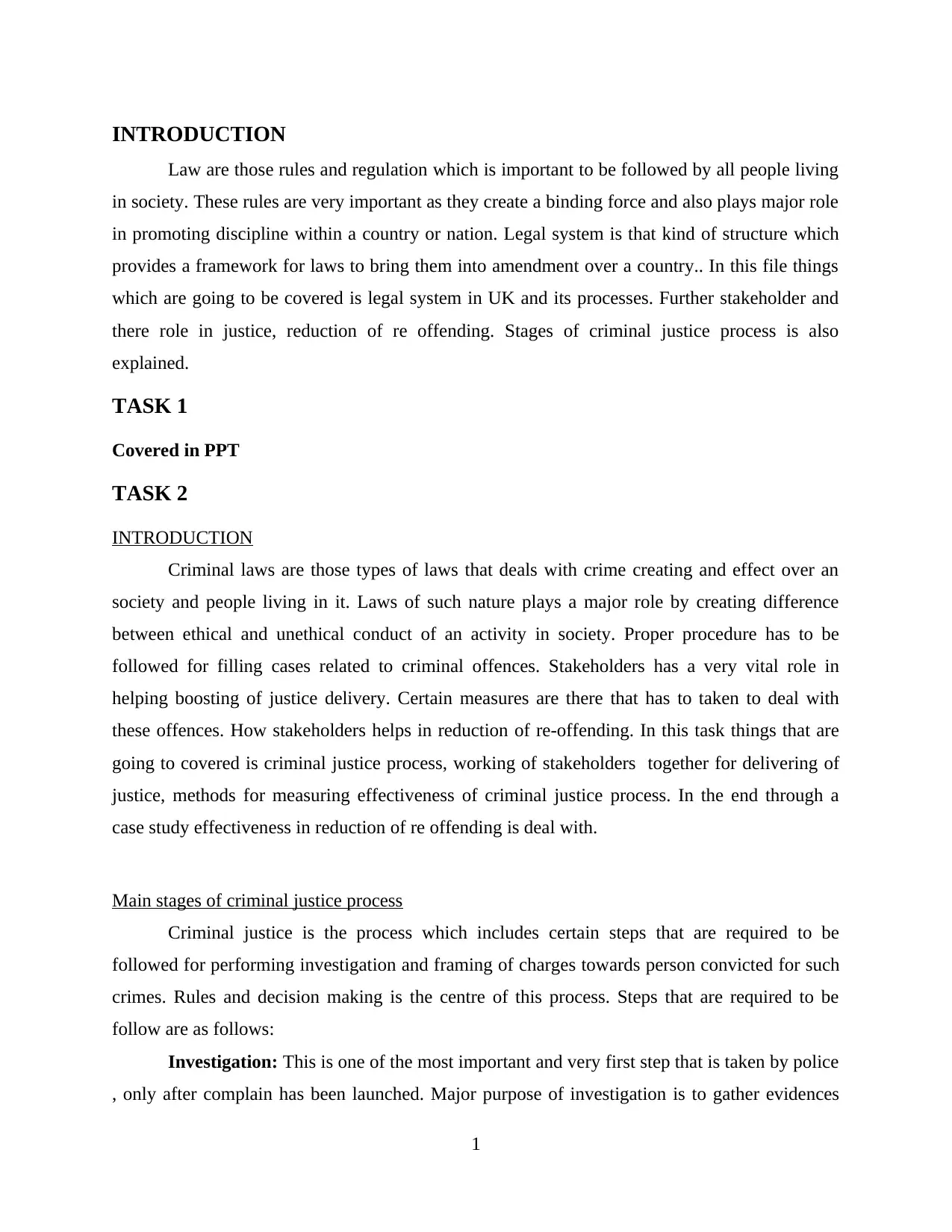
INTRODUCTION
Law are those rules and regulation which is important to be followed by all people living
in society. These rules are very important as they create a binding force and also plays major role
in promoting discipline within a country or nation. Legal system is that kind of structure which
provides a framework for laws to bring them into amendment over a country.. In this file things
which are going to be covered is legal system in UK and its processes. Further stakeholder and
there role in justice, reduction of re offending. Stages of criminal justice process is also
explained.
TASK 1
Covered in PPT
TASK 2
INTRODUCTION
Criminal laws are those types of laws that deals with crime creating and effect over an
society and people living in it. Laws of such nature plays a major role by creating difference
between ethical and unethical conduct of an activity in society. Proper procedure has to be
followed for filling cases related to criminal offences. Stakeholders has a very vital role in
helping boosting of justice delivery. Certain measures are there that has to taken to deal with
these offences. How stakeholders helps in reduction of re-offending. In this task things that are
going to covered is criminal justice process, working of stakeholders together for delivering of
justice, methods for measuring effectiveness of criminal justice process. In the end through a
case study effectiveness in reduction of re offending is deal with.
Main stages of criminal justice process
Criminal justice is the process which includes certain steps that are required to be
followed for performing investigation and framing of charges towards person convicted for such
crimes. Rules and decision making is the centre of this process. Steps that are required to be
follow are as follows:
Investigation: This is one of the most important and very first step that is taken by police
, only after complain has been launched. Major purpose of investigation is to gather evidences
1
Law are those rules and regulation which is important to be followed by all people living
in society. These rules are very important as they create a binding force and also plays major role
in promoting discipline within a country or nation. Legal system is that kind of structure which
provides a framework for laws to bring them into amendment over a country.. In this file things
which are going to be covered is legal system in UK and its processes. Further stakeholder and
there role in justice, reduction of re offending. Stages of criminal justice process is also
explained.
TASK 1
Covered in PPT
TASK 2
INTRODUCTION
Criminal laws are those types of laws that deals with crime creating and effect over an
society and people living in it. Laws of such nature plays a major role by creating difference
between ethical and unethical conduct of an activity in society. Proper procedure has to be
followed for filling cases related to criminal offences. Stakeholders has a very vital role in
helping boosting of justice delivery. Certain measures are there that has to taken to deal with
these offences. How stakeholders helps in reduction of re-offending. In this task things that are
going to covered is criminal justice process, working of stakeholders together for delivering of
justice, methods for measuring effectiveness of criminal justice process. In the end through a
case study effectiveness in reduction of re offending is deal with.
Main stages of criminal justice process
Criminal justice is the process which includes certain steps that are required to be
followed for performing investigation and framing of charges towards person convicted for such
crimes. Rules and decision making is the centre of this process. Steps that are required to be
follow are as follows:
Investigation: This is one of the most important and very first step that is taken by police
, only after complain has been launched. Major purpose of investigation is to gather evidences
1
⊘ This is a preview!⊘
Do you want full access?
Subscribe today to unlock all pages.

Trusted by 1+ million students worldwide

and proofs for framing of charges. An investigation can include search, inspection of property or
of a person. Under probable cause a standard proof is required to proceed. This means that there
are certain facts that apparently indicates about where evidences can be found. Also because of
these facts evidences identification becomes easy (Čyras., Lachmayer. and Schweighofer, 2016).
Arrest: This means taking a person into custody until court gives order to present it. An
arrest can be done after committing of an offence. Under probable cause legal requirement for
arrest should be there.
Prosecution: prosecution under such cases is done by an attorney of district. A
prosecution at the time of proving the charges can present those factors which are important and
has not been identified.
Inducement: It is required while prosecuting is done for an capital offence. Under
criminal cases inducement is required. Charges formed on the basis of charge sheet is decided by
judiciary. It is important as it helps in finding relevant information for such offence.
Arraignment: Before the starting of trial an plea is filed before the judge. These plea can
help in reducing of sentence at later stages of trial.
Plea Bearing: It take place between prosecution and defence attorney. Under this it is
agreed by the defendant to plead guilty that reduces charge and sentence.
Trial of offence committed: Under this all the facts that are important from view point
of proving offence is considered also evidences are analysed. This trial is held before respective
judge of the court.
Sentencing: This is the punishment that has been given by court to the person convicted
for an offence. It can also be considered as period of incarceration.
Appeals: This is filed by attorneys in court of appeal. Then judges hears to appeal. If the
case is reversed by this court, then original trial becomes null void.
Punishment: For criminal offences imprisonment is given and also person has to pay
fines as mentioned under his sentence. These are to be completed by the person sentenced for an
offence.
Stakeholders role in delivering of justice
Stakeholders are those elements or person who plays a major role in boosting justice and
maintaining its stability. These persons can be police officer, judges, lawyers, court personnel or
any other individual. External stake holders are media person and elected officials. All these are
2
of a person. Under probable cause a standard proof is required to proceed. This means that there
are certain facts that apparently indicates about where evidences can be found. Also because of
these facts evidences identification becomes easy (Čyras., Lachmayer. and Schweighofer, 2016).
Arrest: This means taking a person into custody until court gives order to present it. An
arrest can be done after committing of an offence. Under probable cause legal requirement for
arrest should be there.
Prosecution: prosecution under such cases is done by an attorney of district. A
prosecution at the time of proving the charges can present those factors which are important and
has not been identified.
Inducement: It is required while prosecuting is done for an capital offence. Under
criminal cases inducement is required. Charges formed on the basis of charge sheet is decided by
judiciary. It is important as it helps in finding relevant information for such offence.
Arraignment: Before the starting of trial an plea is filed before the judge. These plea can
help in reducing of sentence at later stages of trial.
Plea Bearing: It take place between prosecution and defence attorney. Under this it is
agreed by the defendant to plead guilty that reduces charge and sentence.
Trial of offence committed: Under this all the facts that are important from view point
of proving offence is considered also evidences are analysed. This trial is held before respective
judge of the court.
Sentencing: This is the punishment that has been given by court to the person convicted
for an offence. It can also be considered as period of incarceration.
Appeals: This is filed by attorneys in court of appeal. Then judges hears to appeal. If the
case is reversed by this court, then original trial becomes null void.
Punishment: For criminal offences imprisonment is given and also person has to pay
fines as mentioned under his sentence. These are to be completed by the person sentenced for an
offence.
Stakeholders role in delivering of justice
Stakeholders are those elements or person who plays a major role in boosting justice and
maintaining its stability. These persons can be police officer, judges, lawyers, court personnel or
any other individual. External stake holders are media person and elected officials. All these are
2
Paraphrase This Document
Need a fresh take? Get an instant paraphrase of this document with our AI Paraphraser
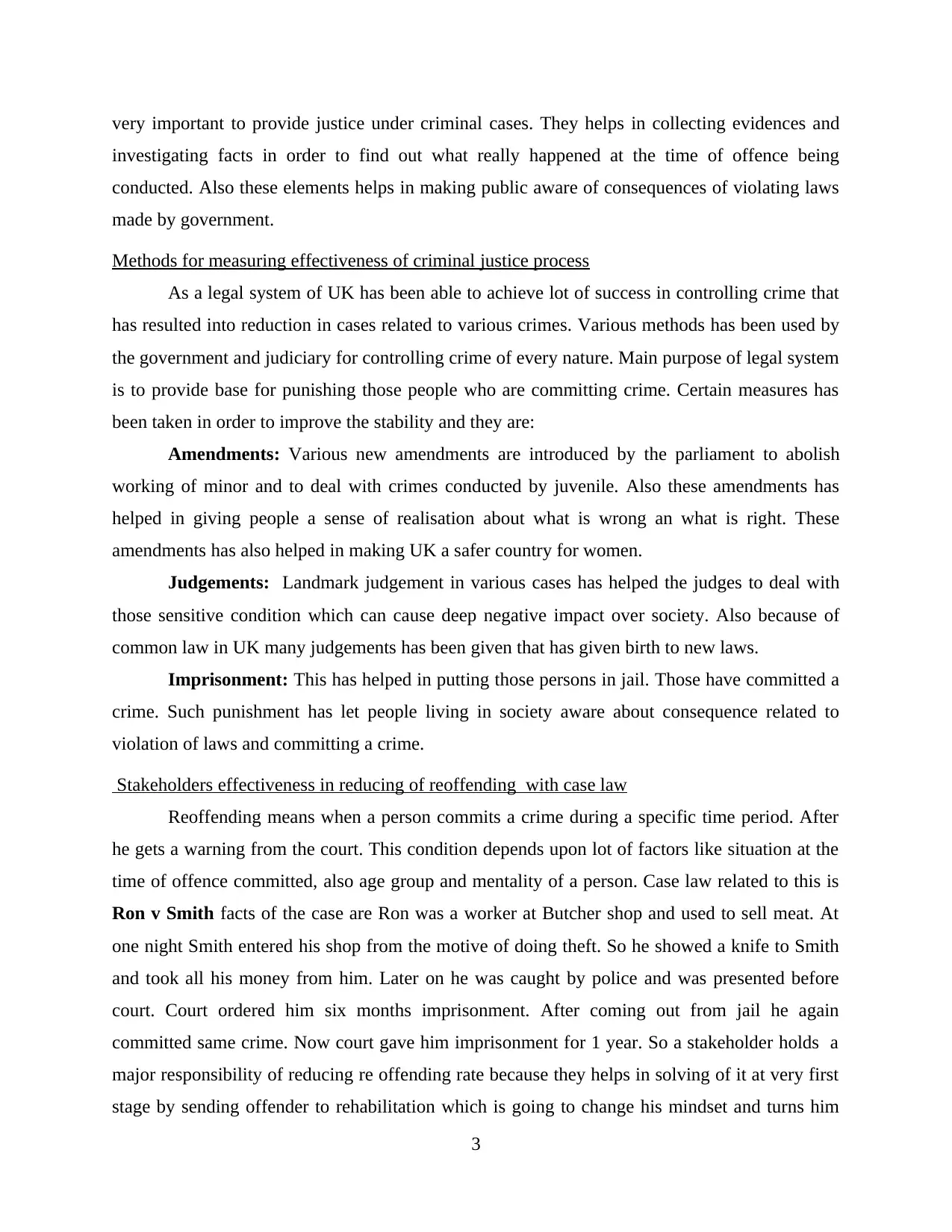
very important to provide justice under criminal cases. They helps in collecting evidences and
investigating facts in order to find out what really happened at the time of offence being
conducted. Also these elements helps in making public aware of consequences of violating laws
made by government.
Methods for measuring effectiveness of criminal justice process
As a legal system of UK has been able to achieve lot of success in controlling crime that
has resulted into reduction in cases related to various crimes. Various methods has been used by
the government and judiciary for controlling crime of every nature. Main purpose of legal system
is to provide base for punishing those people who are committing crime. Certain measures has
been taken in order to improve the stability and they are:
Amendments: Various new amendments are introduced by the parliament to abolish
working of minor and to deal with crimes conducted by juvenile. Also these amendments has
helped in giving people a sense of realisation about what is wrong an what is right. These
amendments has also helped in making UK a safer country for women.
Judgements: Landmark judgement in various cases has helped the judges to deal with
those sensitive condition which can cause deep negative impact over society. Also because of
common law in UK many judgements has been given that has given birth to new laws.
Imprisonment: This has helped in putting those persons in jail. Those have committed a
crime. Such punishment has let people living in society aware about consequence related to
violation of laws and committing a crime.
Stakeholders effectiveness in reducing of reoffending with case law
Reoffending means when a person commits a crime during a specific time period. After
he gets a warning from the court. This condition depends upon lot of factors like situation at the
time of offence committed, also age group and mentality of a person. Case law related to this is
Ron v Smith facts of the case are Ron was a worker at Butcher shop and used to sell meat. At
one night Smith entered his shop from the motive of doing theft. So he showed a knife to Smith
and took all his money from him. Later on he was caught by police and was presented before
court. Court ordered him six months imprisonment. After coming out from jail he again
committed same crime. Now court gave him imprisonment for 1 year. So a stakeholder holds a
major responsibility of reducing re offending rate because they helps in solving of it at very first
stage by sending offender to rehabilitation which is going to change his mindset and turns him
3
investigating facts in order to find out what really happened at the time of offence being
conducted. Also these elements helps in making public aware of consequences of violating laws
made by government.
Methods for measuring effectiveness of criminal justice process
As a legal system of UK has been able to achieve lot of success in controlling crime that
has resulted into reduction in cases related to various crimes. Various methods has been used by
the government and judiciary for controlling crime of every nature. Main purpose of legal system
is to provide base for punishing those people who are committing crime. Certain measures has
been taken in order to improve the stability and they are:
Amendments: Various new amendments are introduced by the parliament to abolish
working of minor and to deal with crimes conducted by juvenile. Also these amendments has
helped in giving people a sense of realisation about what is wrong an what is right. These
amendments has also helped in making UK a safer country for women.
Judgements: Landmark judgement in various cases has helped the judges to deal with
those sensitive condition which can cause deep negative impact over society. Also because of
common law in UK many judgements has been given that has given birth to new laws.
Imprisonment: This has helped in putting those persons in jail. Those have committed a
crime. Such punishment has let people living in society aware about consequence related to
violation of laws and committing a crime.
Stakeholders effectiveness in reducing of reoffending with case law
Reoffending means when a person commits a crime during a specific time period. After
he gets a warning from the court. This condition depends upon lot of factors like situation at the
time of offence committed, also age group and mentality of a person. Case law related to this is
Ron v Smith facts of the case are Ron was a worker at Butcher shop and used to sell meat. At
one night Smith entered his shop from the motive of doing theft. So he showed a knife to Smith
and took all his money from him. Later on he was caught by police and was presented before
court. Court ordered him six months imprisonment. After coming out from jail he again
committed same crime. Now court gave him imprisonment for 1 year. So a stakeholder holds a
major responsibility of reducing re offending rate because they helps in solving of it at very first
stage by sending offender to rehabilitation which is going to change his mindset and turns him
3
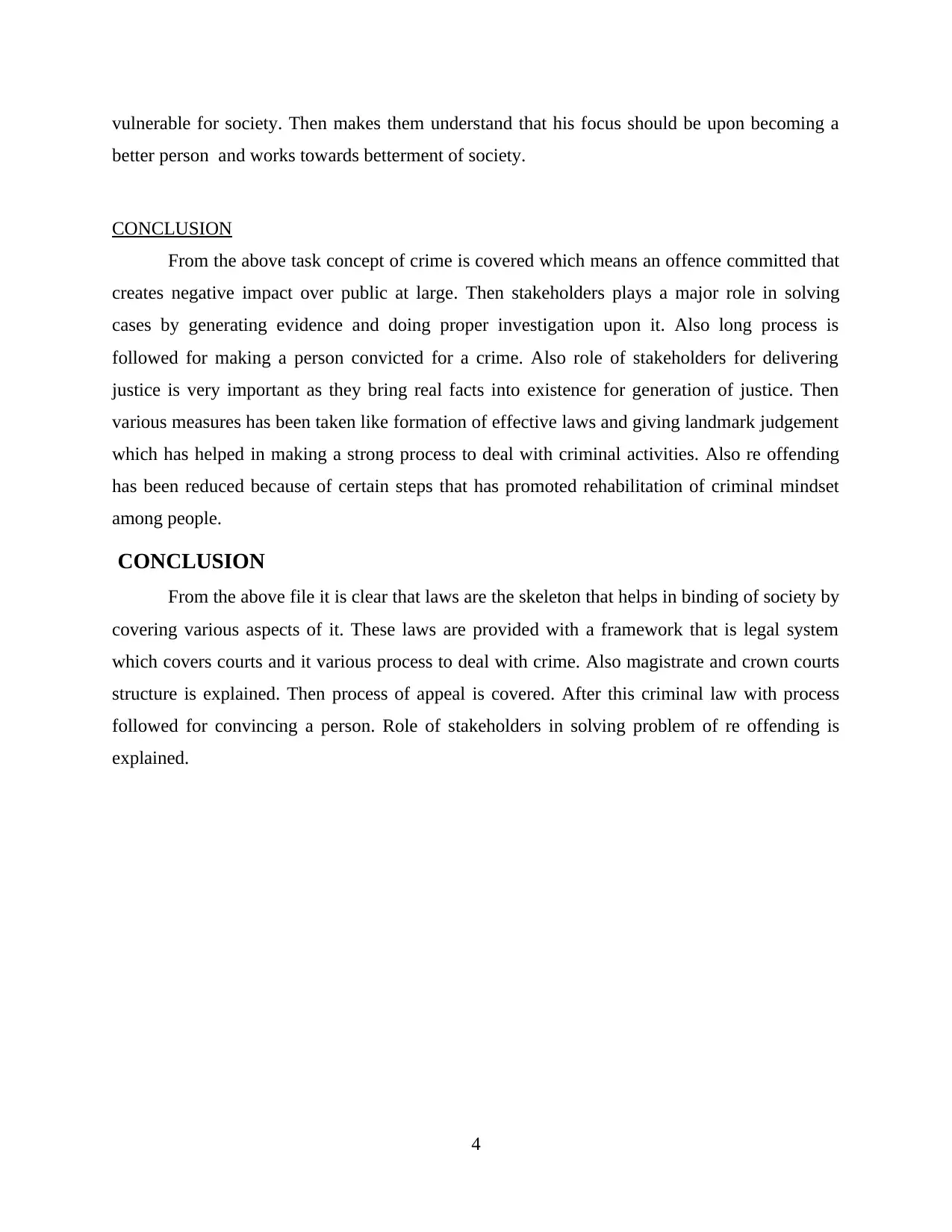
vulnerable for society. Then makes them understand that his focus should be upon becoming a
better person and works towards betterment of society.
CONCLUSION
From the above task concept of crime is covered which means an offence committed that
creates negative impact over public at large. Then stakeholders plays a major role in solving
cases by generating evidence and doing proper investigation upon it. Also long process is
followed for making a person convicted for a crime. Also role of stakeholders for delivering
justice is very important as they bring real facts into existence for generation of justice. Then
various measures has been taken like formation of effective laws and giving landmark judgement
which has helped in making a strong process to deal with criminal activities. Also re offending
has been reduced because of certain steps that has promoted rehabilitation of criminal mindset
among people.
CONCLUSION
From the above file it is clear that laws are the skeleton that helps in binding of society by
covering various aspects of it. These laws are provided with a framework that is legal system
which covers courts and it various process to deal with crime. Also magistrate and crown courts
structure is explained. Then process of appeal is covered. After this criminal law with process
followed for convincing a person. Role of stakeholders in solving problem of re offending is
explained.
4
better person and works towards betterment of society.
CONCLUSION
From the above task concept of crime is covered which means an offence committed that
creates negative impact over public at large. Then stakeholders plays a major role in solving
cases by generating evidence and doing proper investigation upon it. Also long process is
followed for making a person convicted for a crime. Also role of stakeholders for delivering
justice is very important as they bring real facts into existence for generation of justice. Then
various measures has been taken like formation of effective laws and giving landmark judgement
which has helped in making a strong process to deal with criminal activities. Also re offending
has been reduced because of certain steps that has promoted rehabilitation of criminal mindset
among people.
CONCLUSION
From the above file it is clear that laws are the skeleton that helps in binding of society by
covering various aspects of it. These laws are provided with a framework that is legal system
which covers courts and it various process to deal with crime. Also magistrate and crown courts
structure is explained. Then process of appeal is covered. After this criminal law with process
followed for convincing a person. Role of stakeholders in solving problem of re offending is
explained.
4
⊘ This is a preview!⊘
Do you want full access?
Subscribe today to unlock all pages.

Trusted by 1+ million students worldwide
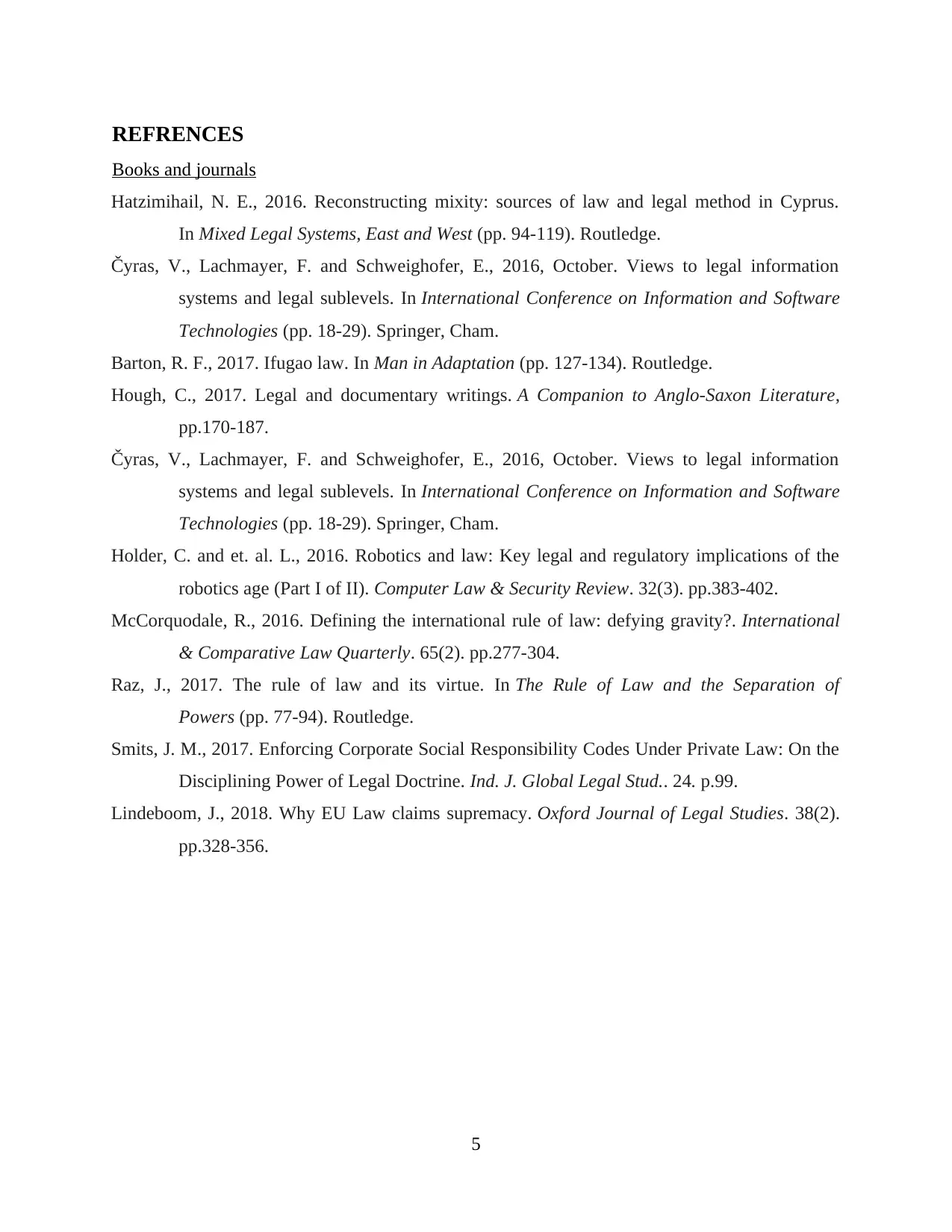
REFRENCES
Books and journals
Hatzimihail, N. E., 2016. Reconstructing mixity: sources of law and legal method in Cyprus.
In Mixed Legal Systems, East and West (pp. 94-119). Routledge.
Čyras, V., Lachmayer, F. and Schweighofer, E., 2016, October. Views to legal information
systems and legal sublevels. In International Conference on Information and Software
Technologies (pp. 18-29). Springer, Cham.
Barton, R. F., 2017. Ifugao law. In Man in Adaptation (pp. 127-134). Routledge.
Hough, C., 2017. Legal and documentary writings. A Companion to Anglo‐Saxon Literature,
pp.170-187.
Čyras, V., Lachmayer, F. and Schweighofer, E., 2016, October. Views to legal information
systems and legal sublevels. In International Conference on Information and Software
Technologies (pp. 18-29). Springer, Cham.
Holder, C. and et. al. L., 2016. Robotics and law: Key legal and regulatory implications of the
robotics age (Part I of II). Computer Law & Security Review. 32(3). pp.383-402.
McCorquodale, R., 2016. Defining the international rule of law: defying gravity?. International
& Comparative Law Quarterly. 65(2). pp.277-304.
Raz, J., 2017. The rule of law and its virtue. In The Rule of Law and the Separation of
Powers (pp. 77-94). Routledge.
Smits, J. M., 2017. Enforcing Corporate Social Responsibility Codes Under Private Law: On the
Disciplining Power of Legal Doctrine. Ind. J. Global Legal Stud.. 24. p.99.
Lindeboom, J., 2018. Why EU Law claims supremacy. Oxford Journal of Legal Studies. 38(2).
pp.328-356.
5
Books and journals
Hatzimihail, N. E., 2016. Reconstructing mixity: sources of law and legal method in Cyprus.
In Mixed Legal Systems, East and West (pp. 94-119). Routledge.
Čyras, V., Lachmayer, F. and Schweighofer, E., 2016, October. Views to legal information
systems and legal sublevels. In International Conference on Information and Software
Technologies (pp. 18-29). Springer, Cham.
Barton, R. F., 2017. Ifugao law. In Man in Adaptation (pp. 127-134). Routledge.
Hough, C., 2017. Legal and documentary writings. A Companion to Anglo‐Saxon Literature,
pp.170-187.
Čyras, V., Lachmayer, F. and Schweighofer, E., 2016, October. Views to legal information
systems and legal sublevels. In International Conference on Information and Software
Technologies (pp. 18-29). Springer, Cham.
Holder, C. and et. al. L., 2016. Robotics and law: Key legal and regulatory implications of the
robotics age (Part I of II). Computer Law & Security Review. 32(3). pp.383-402.
McCorquodale, R., 2016. Defining the international rule of law: defying gravity?. International
& Comparative Law Quarterly. 65(2). pp.277-304.
Raz, J., 2017. The rule of law and its virtue. In The Rule of Law and the Separation of
Powers (pp. 77-94). Routledge.
Smits, J. M., 2017. Enforcing Corporate Social Responsibility Codes Under Private Law: On the
Disciplining Power of Legal Doctrine. Ind. J. Global Legal Stud.. 24. p.99.
Lindeboom, J., 2018. Why EU Law claims supremacy. Oxford Journal of Legal Studies. 38(2).
pp.328-356.
5
1 out of 7
Related Documents
Your All-in-One AI-Powered Toolkit for Academic Success.
+13062052269
info@desklib.com
Available 24*7 on WhatsApp / Email
![[object Object]](/_next/static/media/star-bottom.7253800d.svg)
Unlock your academic potential
Copyright © 2020–2025 A2Z Services. All Rights Reserved. Developed and managed by ZUCOL.





